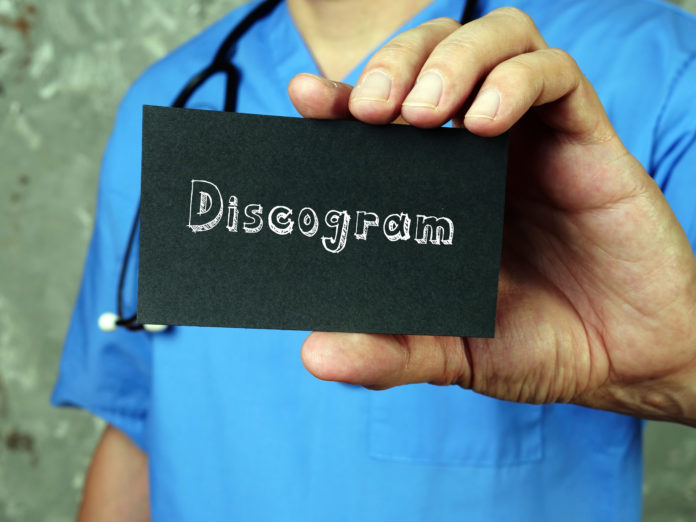A discogram, popularly known as discography, is a type of imaging test done to examine or find the root cause of back pain. Usually, some sensitive disc or a part of it in the spine causes back pain. A discogram can help a doctor determine whether an abnormal disc in the spine is causing the back pain.
About Discogram?
A discogram is a process that involves injecting a dye or coloring agent into the soft center of one or more discs. For a short time, this injection can cause back pain. A dye or coloring agent also penetrates any cracks on the disc’s surface that are visible on an X-ray or a CT scan. A discogram is a type of interventional diagnostic imaging test that is carried out to determine whether a particular intervertebral disc is the source of back pain. Even then, discs that show signs of damage do not always cause symptoms, so the use of a discogram is debatable.
What are the risks of a discogram?
While a discogram is a reasonably safe test, there are a few risks associated with it. Some people are allergic to the dye or the contrast agent injected into a disc. Inform your doctor if you have an allergy to X-ray dye or if you are allergic to any medication. If you are pregnant or have history of allergic reactions, diabetes, asthma, a heart condition, kidney problems or thyroid conditions, please inform your doctor. Inform them if you are taking any anticoagulants such as aspirin.
How should we prepare for a discogram?
On the eve of the test, do not eat anything solid after the time that your doctor specifies . You may require help from your family or friend to be driven to and from the hospital.
What can we expect from the test? How does it work?
Your doctor may advise you to lie down on your stomach or on your side on a table. After skin cleansing, your doctor will administer a numbing medication to remove pain. After that, your doctor inserts a hollow needle through your skin into the center of the disc space and at the same time, he/she can watch an X-ray monitor called a fluoroscope. A fluoroscope, also known as a C-arm, is an arc-shaped piece of equipment that provides X-rays from one side and photographs from the other. Once the needle is inserted, a dye or contrast agent is injected into the disc, which appears white on X-rays.
Fluoroscopy is more accurate and offers a safe needle location into the center of the disc to be examined. A normal disc is one where the dye remains at the center of the disc. If the dye spreads beyond the center of the disc, it signifies that the disc has undergone some damage. If the disc is normal, the injection is painless. Your doctor may ask you to describe and rate your pain during a discogram.
A radiologist can perform a myelogram, which is a diagnostic imaging test, at this point. A myelogram examines the spinal cord with contrast dye, X-rays or computed tomography (computer tomography technique). This test is often called myelography. Myelograms only provide a detailed image of the spinal cord.
After the procedure: Your doctor can complete this procedure within half an hour or an hour and he/she may ask you to be under observation. After some time, you can go back home. It’s normal to feel some pain at the injection site or in the lower back for several hours following the procedure. You can apply an ice pack to the region for 30 minutes with the aid of your family members. You need to maintain post-operative hygienic conditions to avoid any complications.
What are the possible results of the test?
Your doctor will examine the images and information you provided about the pain you experienced during the procedure to help determine the source of your back pain. Your doctor will use this information to guide your treatment or to prepare you for surgery. Doctors typically do not rely solely on discogram results because a deteriorating disc may not cause pain. Furthermore, pain responses during a discogram can vary significantly. The results of a discogram are conventionally cumulated with the results of other tests, such as an MRI or a CT scan, and a physical examination, when determining a treatment plan for back pain.
When do we need to see a doctor?
If your back pain persists, consult a doctor. If conventional treatments like medication and physical therapy are failing, your doctor may recommend a discogram. Doctors use discograms to identify removable, painful discs before performing spinal fusion surgery. After the test, if you experience severe back pain or a fever one or two weeks later, contact your doctor immediately.
.
Call 1860-500-1066 to book an appointment.
Conclusion
The results of a discogram may confirm the need for surgery as well as specify the correct cause of your back pain, increasing the possibility of a particular outcome from surgery.
Frequently Asked Questions (FAQs)
How long does it take to get a discogram?
The discogram procedure takes 30 to 45 minutes on an average. You will be kept for 30 to 60 minutes for visual examination.
What is a CT myelogram and how is it done?
A myelogram is an invasive diagnostic test that examines the spinal canal with X-rays. A hollow needle is used to inject a special dye into the spinal canal. Myelograms can reveal problems with the spinal cord and nerves that run through the spinal canal.
What does it mean to have a positive discogram?
The injection will temporarily reproduce your symptoms if a disc is the source of your back, spine, extremity and/or leg pain, resulting in a positive discogram. The injection will not reproduce your symptoms or cause any discomfort if the disc is not the source of pain, resulting in a negative discogram.


















